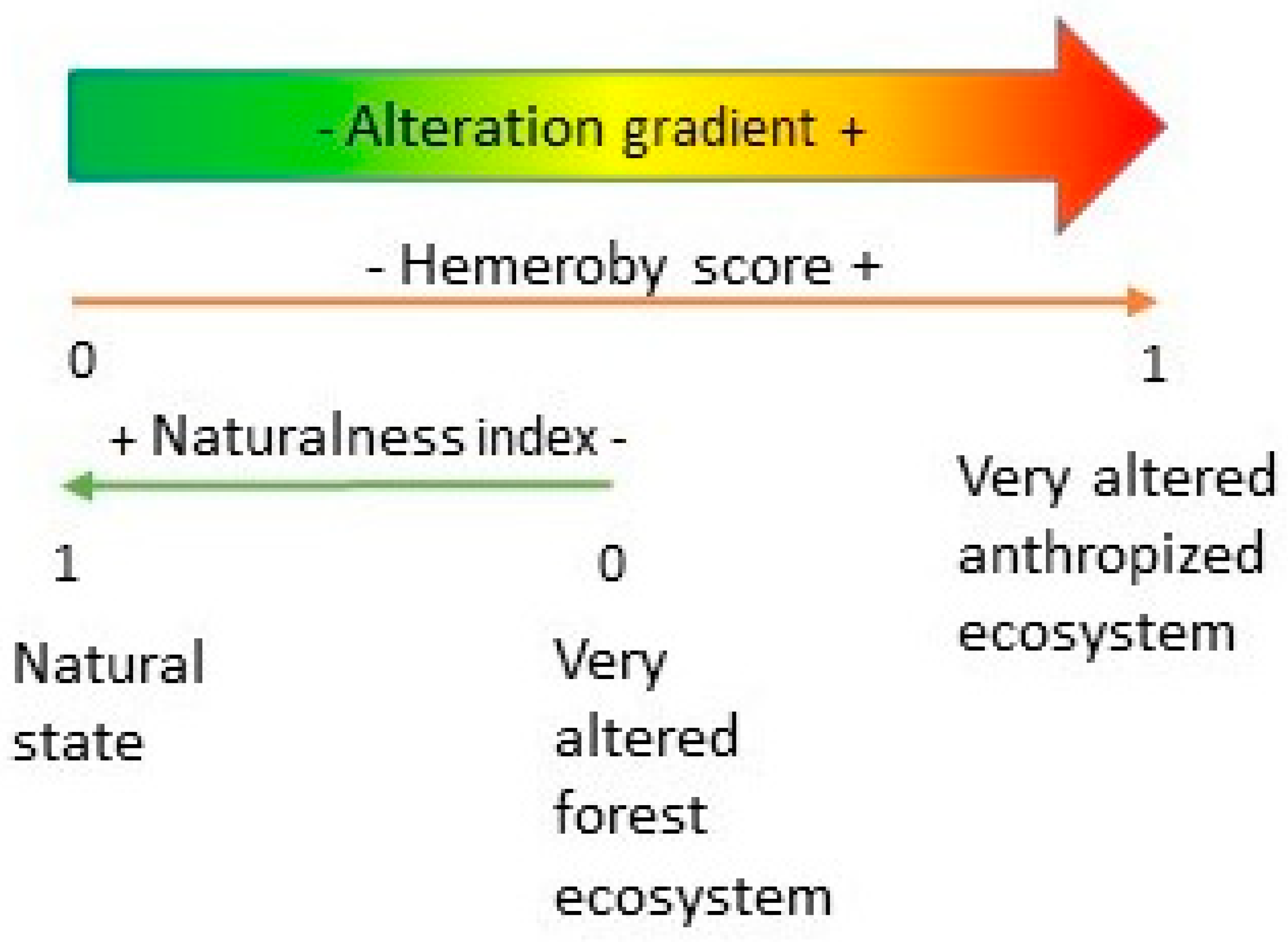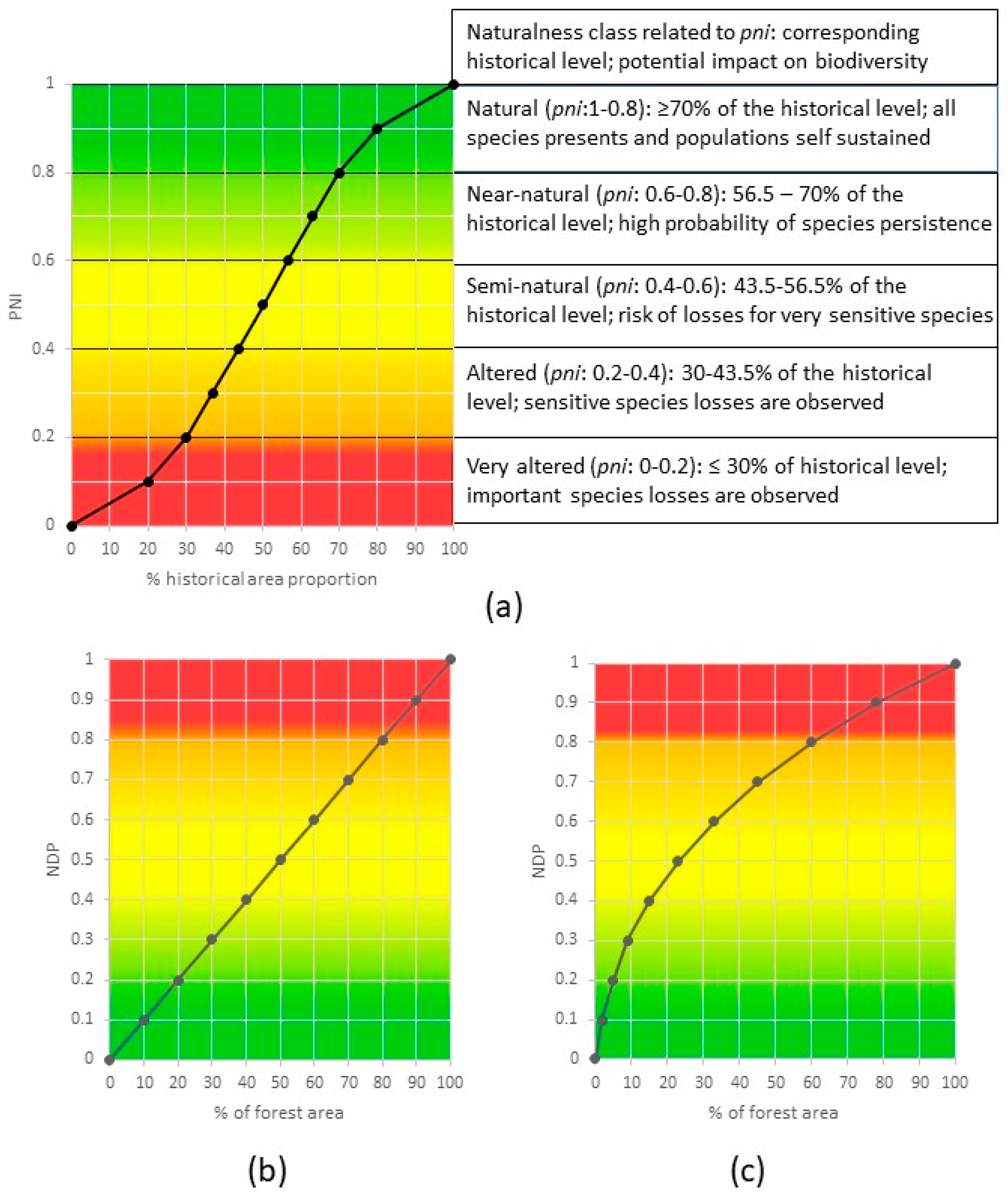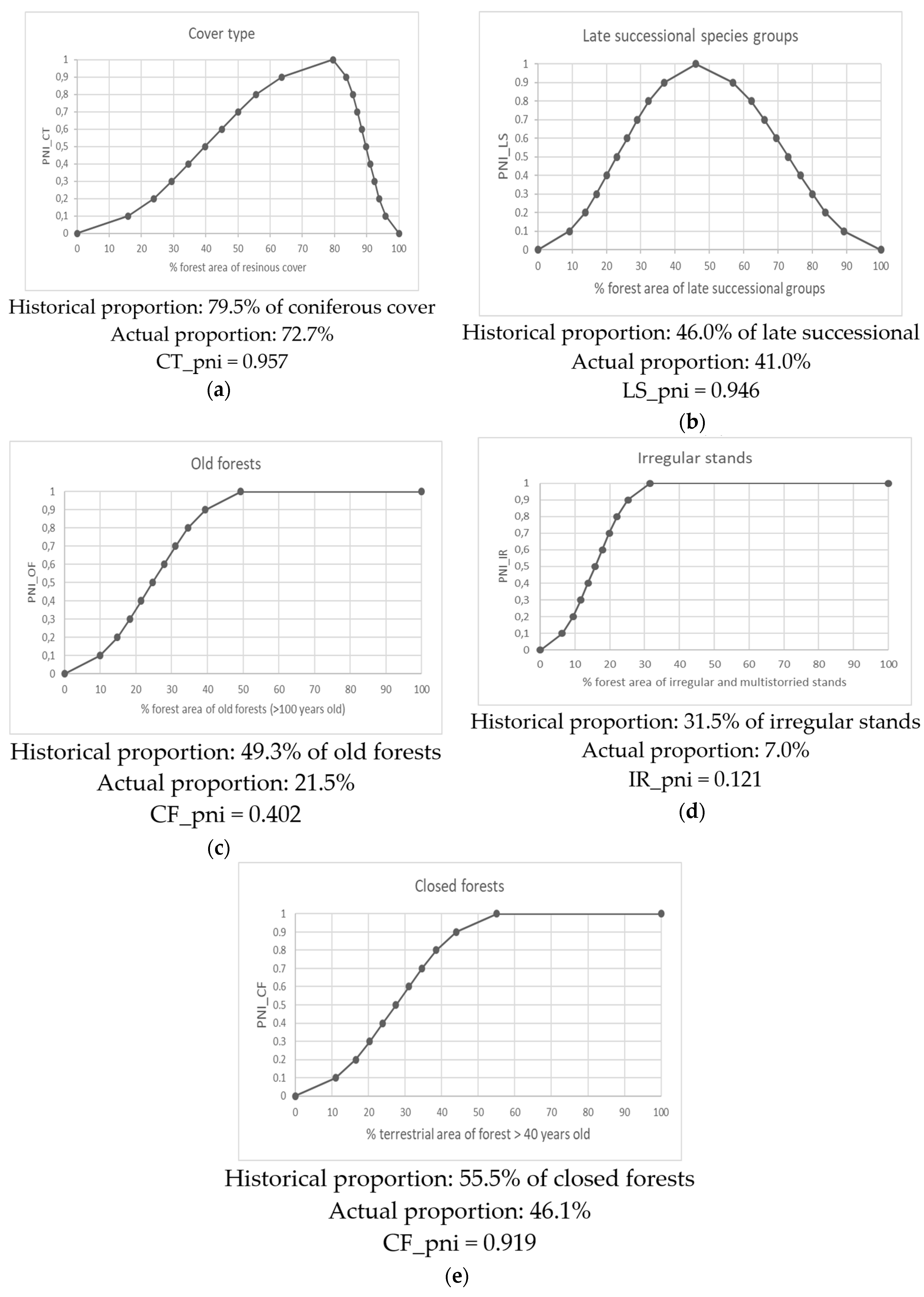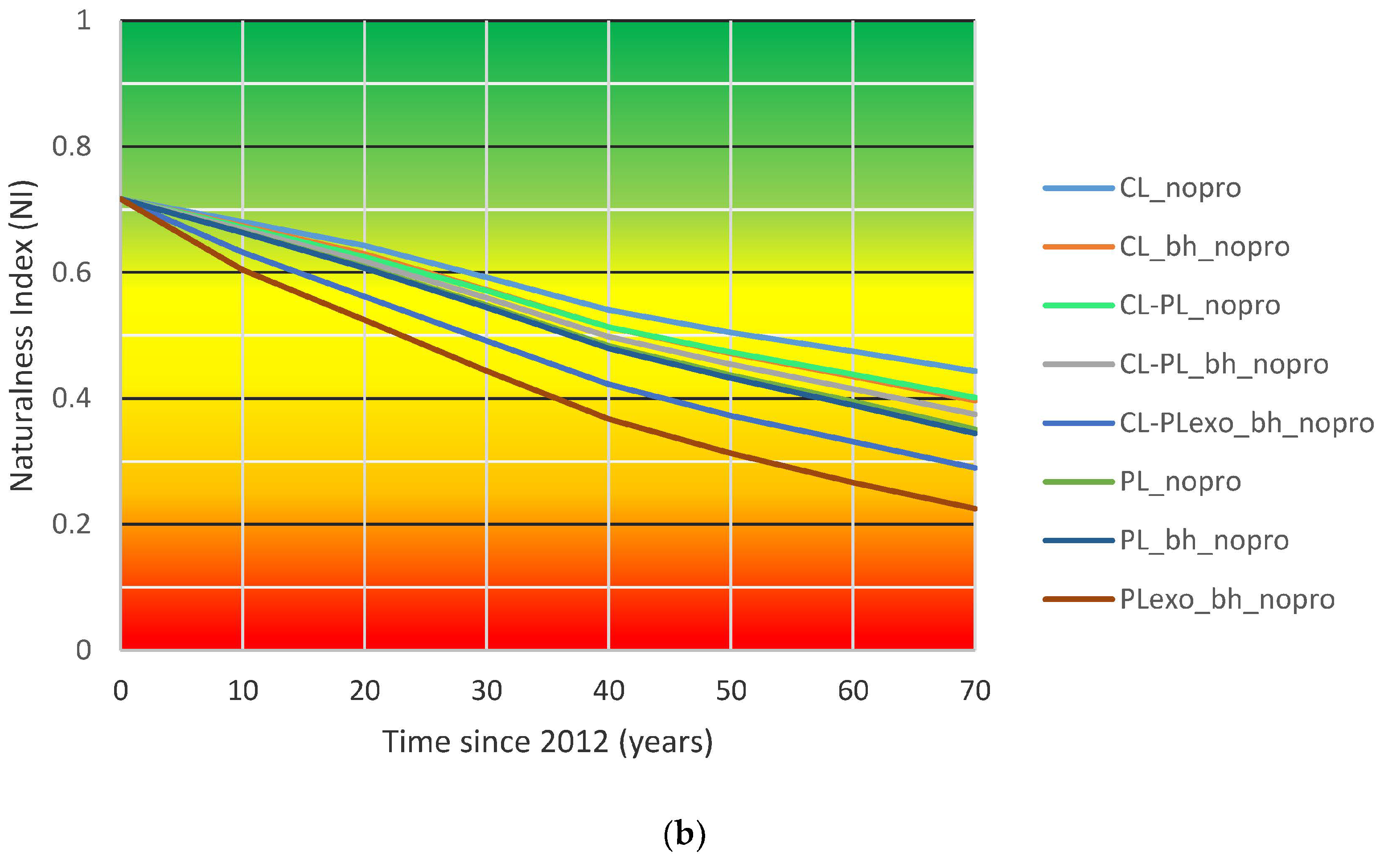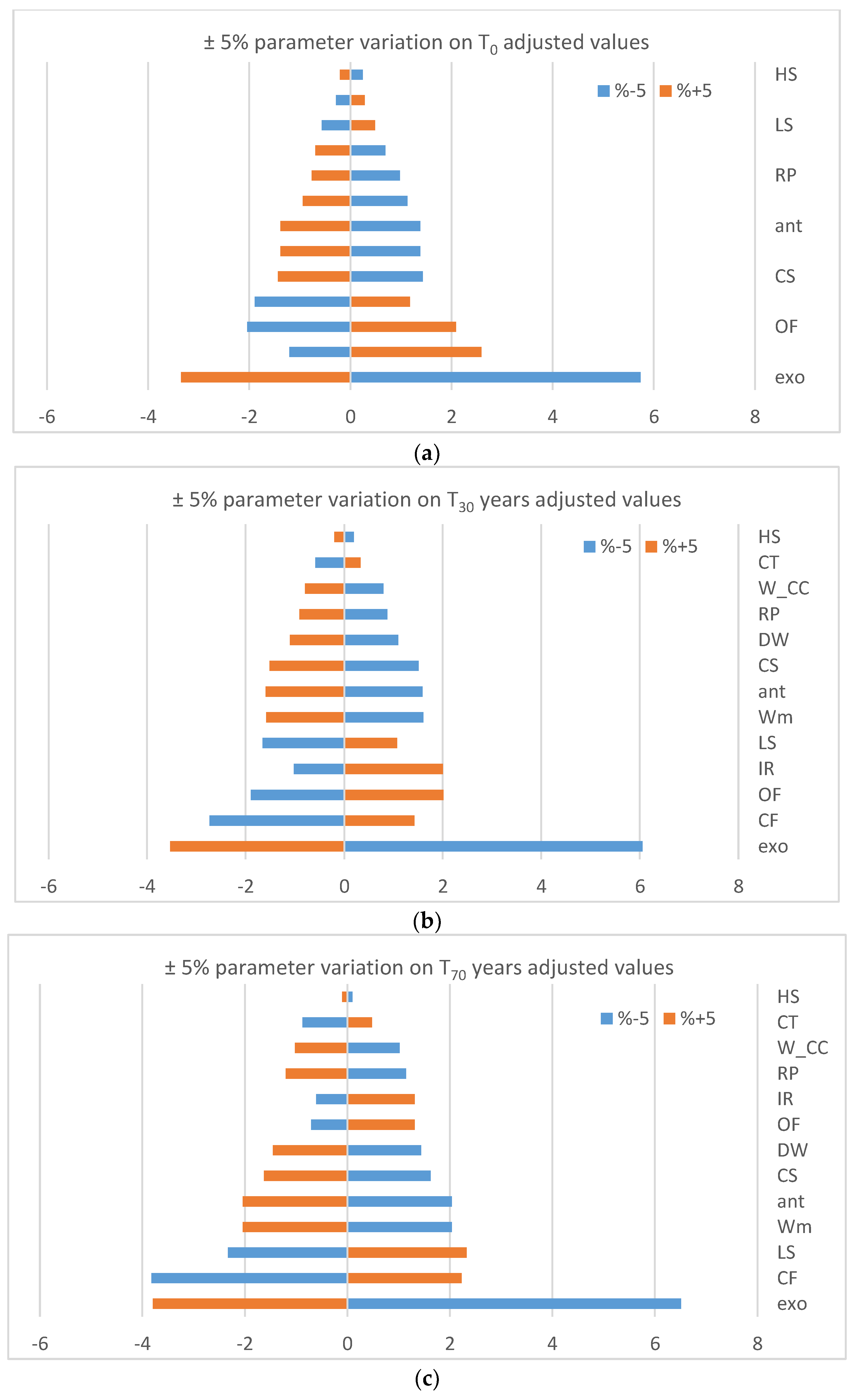1. Introduction
Quantitative tools to discriminate between different wood supplies depending on forest management and wood procurement practices are needed to inform architects and designers planning the eco-design of buildings. Using the science of applied ecology, such tools should make it possible to evaluate and compare the impact of different forestry strategies and the combination of practices on the quality of forest ecosystems.
This study aims to develop a methodology to characterize the potential impacts on ecosystem quality of different forestry management practices, in the perspective of describing the intensity of land use as driven by forestry. The methodology is based on the naturalness concept and relies on forest inventory maps and data. Our methodology allows the evaluation of combinations of practices and provides one numerical index, a suitable format for further use in decision-making support tools for eco-design and green building conception, such as life cycle analysis (LCA) [
1]. An area within the boreal black spruce ecological domain of Quebec (Canada) was used as a case study for the development of the methodology.
The specific objectives of the study are to:
- (1)
Develop a naturalness evaluation model using the example of the boreal black spruce-feathermoss ecological bioclimatic domain of Quebec (Canada).
- (2)
Apply the model over time on three forest management units (3 FMU) to analyze the variability of the naturalness evaluation associated with changes in forest management strategies and practices.
- (3)
Perform a sensitivity analysis of the model to (hypothetical) high pressure levels and to identify the most sensitive variables.
The need for evaluating the quality of ecosystems in relation with their anthropic uses presents many challenges. As land use, and particularly land use change, is one of the main drivers of biodiversity loss [
2], there is a desire to express its impact on the quality of ecosystems in terms of biodiversity damage in LCA [
3,
4]. The latest proposed LCA approach uses potential species loss from land use as an indicator; for forestry, it considers two land use intensities (intensive and extensive) [
3]. This proposal raises two issues: Biodiversity data and indicators’ availability, and land use intensity evaluation. Concerning biodiversity, potential species loss is still proposed as the biodiversity indicator even if it does not reflect the multidimensional character of biodiversity and might lead to inappropriate conclusions [
5]. As stated by Souza et al. [
6], the biodiversity models proposed up to now do not grasp the full reach of the phenomena involved, such as functional effects and impacts on populations. Furthermore, there are data gaps in biodiversity: Biodiversity data are often fragmentary (they do not include all taxa) and of varying quality (all biomes are not evenly studied, especially the boreal biome for which data are particularly scarce). For instance, boreal forests are underrepresented in global biodiversity databases (see GLOBIO [
7]; PREDICTS [
8]). Concerning the intensity, forest management strategies generally include a mix of practices that have different impacts on the ecosystem, and the intensity is related to the recurrence of treatments over the same area planned in the silvicultural scenario. Because of these issues, we propose an alternative approach to evaluate ecosystem quality related to forest management, one that focuses on habitat characteristics and the concept of naturalness.
Many authors have proposed to use the concepts of naturalness and hemeroby in impact evaluation of land use (such as forestry) on the quality of ecosystems in LCA [
9,
10,
11,
12,
13]. Naturalness is defined as “
the similarity of a current ecosystem state to its natural state” [
14], whereas hemeroby expresses “
distance to nature” in landscape ecology [
11]. The use of these concepts can provide a management guide that overcomes the challenge of data gaps in biodiversity. Even if the concepts of naturalness and hemeroby are closely related, one is not the exact inverse of the other. There is also divergence concerning the highest degree of alteration that should be included [
14]. To clarify, we associate the naturalness concept with forest ecosystems, as shown in
Figure 1; its lower class, i.e., the most altered state, corresponds to artificial forests [
15,
16] created by humans and showing deep modifications to the ecosystem and its species composition [
15]. On the other hand, in the hemeroby scale, the alteration gradient is further developed and extended to sealed soils, and constructed, degraded, or devastated areas [
11], with some authors even distinguishing dumpsites and partially built areas from sealed soils [
9]. As stated by Winter [
14], “
greater naturalness is characterized by a large number of adapted, specialized and often endangered plant and animal species”. Thus, in order to prevent or limit forest biodiversity loss due to forestry, the emphasis should be put on maintaining or restoring a high degree of naturalness. The concept of naturalness is well adapted to evaluate forestry management practices, but its application to evaluate the full alteration range of different land uses beyond forestry will require further work for proper insertion in the hemeroby concept that addresses a larger alteration gradient. Since the scope of this paper focuses on the impacts of forest management practices, the evaluation is restricted to the naturalness part of the alteration gradient.
The use of an index to evaluate the departure from the natural state along the alteration gradient avoids the problem of multiple classification of naturalness encountered in the literature [
18] and allows inclusion of realistic forest management strategies, which involve a mix of different practices. Naturalness evaluation based on habitat characteristics is possible with actual data, and the future evolution of characteristics can be predicted. However, impacts on biodiversity are more challenging to assess considering the need of biodiversity indicators that encompass multidimensional characteristics of the biodiversity concept [
5] and the uncertainty related to the timelag existing between habitat destruction and species extinction or extirpation [
19].
Forest naturalness can be defined and evaluated using three interdependent approaches based on structure (i.e., spatial arrangement of the various components of the ecosystem [
20]), composition, and processes [
21]. Generally, naturalness assessment results from the comparison between the actual condition and a reference state [
22] using either historical inventory data, prior to commercial forest exploitation, or modelling studies of forest dynamics evaluating the range of natural variability [
23]. Where historic data are not available, the reference state, which corresponds to the most natural state, can be associated with a position along the alteration gradient [
17]. Many methods have been proposed to assess naturalness [
14], which is coherent with the fact that the choice of variables for naturalness studies must be adapted to regional conditions and knowledge [
17].
The method developed here uses condition and pressure indicators. Indicators correspond to specific “elements of the forest system (e.g., species, processes and habitats) that correlate with many other unmeasured elements of the system” [
24]. Condition or state indicators describe the current status or condition of a characteristic; pressure indicators represent the level of a pressure that affects the condition of a characteristic (i.e., an action that is causing the condition to degrade or improve) [
24]. Thus, condition indicators are related to the concept of naturalness (i.e., the similarity of a current ecosystem state to its natural state), whereas pressure indicators are rather related to the hemeroby concept (i.e., distance to nature). However, pressure indicators can still be used to evaluate naturalness considering their effects on the condition of a characteristic.
We developed our conceptual model for naturalness assessment at the landscape level in a way that it could be easily adapted to other contexts and available data. Our method explores the application of non-linear relationships to integrate the notion of ecological thresholds in the naturalness assessment; habitat thresholds correspond to points or zones at which relatively rapid changes occur from one ecological condition to another [
25]. We also propose an original method for handling condition and pressure indicators in the index calculation.
4. Discussion
Decision support systems depend upon summaries and systematic reviews available at the time of their conception and are therefore subject to improvements as new information becomes accessible [
26]. Nevertheless, the conceptual model developed in this study provides a basic frame for naturalness assessment, although indicators, measures, and curves might be revised when better information and data become available.
4.1. Conceptual Model
Evaluating the intensity of silvicultural management makes it possible to quantify land-use intensity in forests. Gossner et al. [
40] showed that biodiversity can be related with land use measures, such as naturalness based on trees species composition, dead wood, and other structural characteristics, or stand management intensity based on tree species, stand age, and aboveground living and dead woody biomass. Therefore, a methodology combining the condition evaluation of composition and structure, and pressure measures resulting from silvicultural practices represents a good proxy for the evaluation of the effects of forestry on biodiversity resulting from a combination of various practices. Further research is needed to verify to which extent the utilization of condition measures can detect improvements of naturalness resulting from restoration or enhanced ecological management strategies. The inclusion of pressure measures can adequately reflect the effects of mitigation measures, although the model should be further validated. Our results suggest that the presence of strict protected areas in a forest landscape compensates, to some extent, for the impacts of intensive management [
41].
The model developed in this paper was shown to be sensitive enough to characterize the naturalness of different forestry management systems and therefore discriminate between different wood supplies from a variety of forest management practices. The results demonstrate that the proposed naturalness assessment model can be useful to evaluate the land use intensity of forestry practices at a finer level than existing approaches to inform decision-making in life cycle assessment. For instance, global guidance for life cycle impact assessments [
3] currently considers only two levels of intensity for forestry: Intensive and extensive forestry. For their part, Chaudhary and Brooks [
42] proposed to divide secondary vegetation in four classes: Plantations, clearcut, selective logging, and reduced impact logging. In contrast, our approach makes it possible to take into account the condition of the forest as well as the proportion of different practices to more precisely characterize the forest management strategy and its impacts on ecosystem quality.
The application of pressure as a reduction of the condition contributes to an important reduction of the naturalness resulting from the progression of the first cutting cycle over the area. Such an important reduction of the quality observed as a result of the initial land use transformation process is coherent with the conceptual model proposed by LCA developers for ecosystem quality evolution related to land use [
43]. However, tests over time highlight some specificities of forestry land use reflected by the model. Contrary to most land uses, the first cutting cycle of a forest land corresponds to a progressive transformation from the natural state to a naturalness level related to the forest management strategy applied. In Quebec’s boreal forests, this initial transformation may take up to 100 years. During the subsequent rotations, the naturalness index tends to stabilize as a result of the normalization of the forest, supposing that sustainable management is used. However, our model indicates a trend toward a slow erosion of the ecosystem quality over time during the sustainable production phase. If the land use ever stops and constraints are relaxed (although future land use changes are more likely to progress toward land uses of higher hemeroby), the naturalness should progressively improve as condition indicators will gradually recover with the aging of the forest. However, we do not know if condition indicators will ever come back to the natural state after relaxation. Nevertheless, some pressures will remain (ex: Drained wetlands or other anthropic features, like permanent roads, energy transportation lines, etc.), so theoretically the ecosystem should never recover completely.
Given the model’s sensitivity to age related variables, a better integration of plantations would be necessary to improve the results. It would be interesting to explore the application of the naturalness assessment model using data from sustainable harvest calculation systems to reflect the effect of forest management strategy implementation considering simultaneously shorter rotation for plantations, application of the modelled composition and growth, simulation of harvest spatially applied to the admissible area, and a different handling method of natural disturbances [
44].
The natural assessment model developed in our study was designed to be easily adapted to other regions using the conceptual model. All five naturalness characteristics should be considered, indicators should be reviewed to include all regionally important ecological issues, and measures should be identified among available data. Curves for condition indicators would then have to be calibrated using the specific historical values of the studied region and NDP factors should be adjusted to reflect regional practices’ effects.
Our model could also be integrated in LCA models and used to inform building and construction eco-designers beyond the outcomes of this specific case study. To do so, further work still needs to be done to generate regionalized results across Canadian FMUs and ecosystems. Depending on the availability of historical data, naturalness assessment could be performed for ecological domains or sub-domains (ex. Western black spruce feathermoss sub-domain); aggregated results could be calculated by region or country to allow for the assessment of harvested wood products in a broader context, where the exact provenance of the wood is not known.
4.2. Naturalness Assessment Application to the 3 FMU
The results of the case study inform us that wood coming from the 3 FMU has less negative impacts on the quality of ecosystems if the management strategy relies on natural regeneration through careful logging instead of plantation, especially if exotics are involved. It is still possible to limit the potential loss of specialized species resulting from sustainable forest management provided that the proportion of strict protected areas is sufficient to mitigate the degradation of the condition indicators.
The following observations raise questions that should be further addressed in LCA. The actual naturalness of the 3 FMU is near-natural as a result of a rejuvenation through the harvest of 22.3% of the forest area, including plantation of indigenous species over 5% of the forest area. The difference between management scenarios results from the cumulative effects of practices over time, mainly those inducing rejuvenation, the model being sensitive to age-related variables (OF and CF). Given that the naturalness index tends to stabilize after the completion of the first cutting cycle, the naturalness assessment of a forest management strategy requires an evaluation over the whole cutting cycle. This corresponds also to the potential impact of the forest regime. However, actual naturalness could be used if the objective is to characterize the naturalness of the forest from which the wood is currently procured. The actual naturalness is the result of the practices applied up to now. It does not necessarily correspond to the level resulting from sustainable management, which is more consistent with the evaluation over a whole cutting cycle. In a territory including forests that have never been harvested, such as the 3 FMU, actual naturalness gives an optimistic portrait and does not correspond to the potential impact of the present activities.
Some important limitations of the use of the model in Quebec’s boreal forest need to be stressed. The model could not be used to evaluate the naturalness index in the test area beyond the first cutting cycle, as no data was available to describe the future evolution of the composition of secondary forests in that area. Pni and NDP evaluation curves and factors should be validated according to expert opinion.
The uncertainty of the results increases over time; the evolution of forest composition in older secondary forests (>40 years) in this ecological domain has yet to be verified. The future evolution of the natural disturbance regime under a changing climate is also unknown. Therefore, its effects on age structure are unknown as well as the proportion of future regeneration failures, which affects the closed forest coverage. Nevertheless, the importance of the proportion of old forests and irregular stands, and eventually closed forests, is coherent with present concerns related to age structure when attempting to apply ecosystem-based management [
27].
